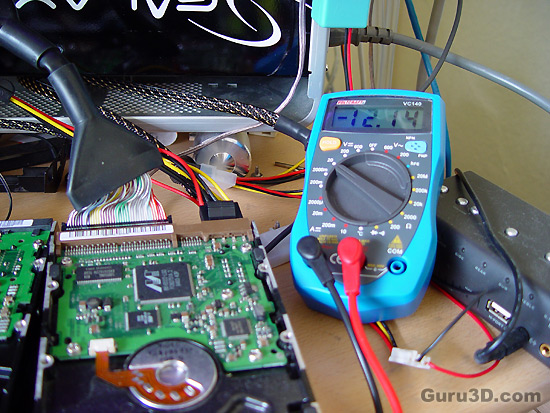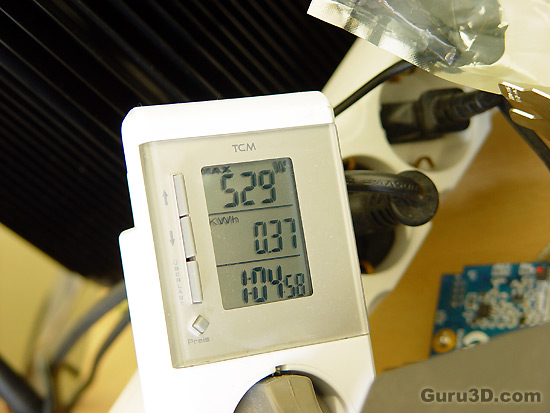Page 7
For gamers with (Quad) SLI/Crossfire, the most power draw will be at the 12 volts rails. Here we see the 12 volts line when the system was in idle; at 12.11 Volts.

Now here we see the 12 volts (2) rail when the SLI setup was 100% at work and peaking. This was the maximum variation shown in the test and is unbelievably stable.
Okay you get the idea already, stable as a rock and all that without any harsh noise from the fans. Pretty "vigorous" stuff. Let's place our findings in a chart.
We have measured all voltage lines with a multi-meter directly at the device or mainboard. These are not BIOS measurements. We measured two "states". The system pretty much doing nothing (idle) and the system stressed out 100% (load).
Here we took some of the voltages in both IDLE and LOAD (fully utilized) modes. We noted down the lowest and highest value we saw and that is the fluctuation. If a PSU is unstable we'd see some fluctuation, differences and discrepancies which can result in system instability.
Now, what you need to understand is that on each of the voltage rails, a 5% tolerance would be the accepted as normal according to the ATX spec, meaning the power-supplies actual voltages should stay somewhere in-between the values. Suffice to say that tolerance actually stays within 0.1% is crazy.
When we look at total PC system power consumption we need to realize we are not pushing roughly 530 Watts on this system. Excessive yes, but the PSU isn't even trying to push hard. The PSU remains cool, the voltage rails stable.

A maximum 529 Watts peak ... that's pretty low; also because of the very high 80-85% power efficiency of the PSU. That also saves you money on your power bill.
Conclusion; this thing is STABLE.
Now then, you've had a peek at the photos, combined all factors, and now you should have a pretty broad idea of how this PSU would function for your current or future PC. Quite honestly, I did my best. In a 3D intensive test run with 100% utilization in an overclocked environment.. This little toddler is stable for sure, and remember this was tested on a very expensive 2500 USD NVIDIA High-end SLI system.
Sound - we have to include a quick stroll regarding noise levels these days. I've had cheap PSU's in this office that likely could have functioned as active rotating helicopter blades when they got a little hot. This PSU doesn't need much wording in this regard though, it simply is quite silent, yet audible. The heat on the inside of the PC is being sucked outside the PC, creating airflow with the help of a 135mm fan for quiet cooling due to its ability to move a large volume of air at low RPM. Additionally we see a rear mounted 80mm fan for optimal airflow and thus cooling. So, hot air traveling in an upwards direction will be partly ventilated towards the outside where colder air is due to ventilation. Quite silent and sufficient enough to cool the PSU.
dBA levels are hard to measure, we did however, and the results: Really silent at 36 dBA which pretty much can be classified as inaudible.
